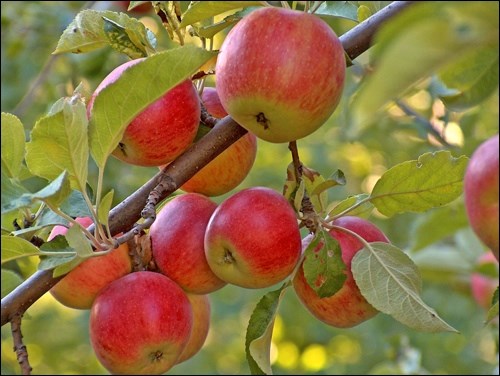Apples that are grown in the prairies are as good as apples grown anywhere! However, how you decide what apple to grow is sometimes difficult. Please read on and tempt your taste buds to grow your own apples.
The following are some of the more popular cultivars of prairie-hardy apples. By definition, an apple tree that produces fruit that is 5 cm or larger in diameter is considered a true apple. Fruit that is 3.5 to 5.0 cm in diameter is classified an apple-crab, and fruit smaller than 3.5 cm is a crabapple.
Early Season Apples (August)
Heyer 12 is very hardy selection made from a seedling of a Russian apple by Mr. Adolph Heyer, an amateur fruit breeder from Neville, Sask. Due to its extreme hardiness, and its high degree of fire blight resistance, it has remained a reliable apple for prairie conditions since its introduction in 1940. Fruit is 5–6 cm, round, yellow-green with no red colour. Flesh is creamy white, coarse, and mildly acid. The fruit breaks down very quickly and will not store for more than a couple days.
Norland is a good quality, medium sized, (6–7 cm) apple suitable for fresh eating or cooking. Fruit shape is oblong conic, slightly ribbed; skin has greenish yellow base colour and a 50–60 per cent washed and striped dark red over colour. Flesh is cream colour tinged slightly green and slightly course in texture. It has good flavour with moderate acid. Fruit ripens in mid to late August and stores very well, especially if picked slightly before full maturity. Trees are semi-dwarf, upright spreading and annually productive. Trees are considered hardy to zone 2a but somewhat susceptible to fire blight.
Westland is a large (7–8 cm) apple with fair quality for eating and good quality for cooking. Fruit shape is round conic with slight ribbing. Skin is yellowish, with 10–20 per cent washed and striped light red. Flesh is creamy white tinged red; flavour is moderate acid and sweet. Fruit ripens in mid to late August and stores moderately well (up to eight weeks). Trees are semi-vigorous with wide angled crotches and are annually productive. They are hardy to zone 1b if provided some protection. Westland is suggested as a replacement for Heyer 12 as a hardy cooking apple.
Mid-Season Apples (late August to late September)
Adanac has fruit that is 6 cm in diameter, with green skin with red stripes. The flesh is greenish-white, slightly coarse, slightly acid and good for fresh eating cooking and juice. It forms round-headed, semi-dwarf trees with good branching habits. It is resistant to fire blight and hardy to 2a.
Battleford has fruit of 7 cm in diameter with greenish-yellow skin mottled and streaked with red. The flesh is yellowish-white, somewhat coarse, and slightly acid. It stores for one month and can be eaten fresh, used for cooking or juicing. It has limited resistance to fire blight, and is of reliable hardiness only to zone 2a.
Breakey produces 6–7 cm diameter apples that are round with amber coloured skin that is striped with red. It matures in September. The flesh is white, fine textured, flavourful and juicy. It is excellent for fresh eating, cooking and juice and stores well for eight weeks. It requires a protected site in zones 3 and 2b and is susceptible to fire blight.
Watch next week for more apple cultivars that you can grow!
Hanbidge is a horticulturist with the Saskatoon School of Horticulture and can be reached at growyourfuture@gmail.com
We have some great workshops coming up!
If you like to design with flowers, you might want to check out the upcoming floral design courses this April 16 and 17 at the Saskatoon School of Horticulture.
Design your own landscape: April 16, 23 and 30.
Pruning workshop is May 7.
Enrol now for distance courses leading to a diploma or a certificate. Study with us or study in the comfort of your own home! Please contact us for further information or visit our website at saskhort.com
Let our team of experts help you to create the outdoor living area of your dreams. Our team of educated and skilled experts can build or renovate your new or existing landscape. Including decks; gazebos; sunrooms; solariums; retaining walls; fences; irrigations systems; and regular maintenance.
Target Certificate in Horticulture Program … learn from the comfort of your home and gain the skills and education to work in the field of horticulture. Graduates from SSH are recognized by the industry as superb additions to help their horticultural business grow!
Like us on facebook at Saskatoon School of Horticulture and get in on all the events coming up and follow us on twitter @horticulturepat
For more information on any course or to register please contact: Saskatoon School of Horticulture by phone at: 306-931-GROW (4769); by fax at: 306-955-GROW(4769); or by email at: schoolofhorticulture@sasktel.net.



